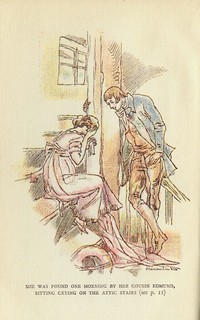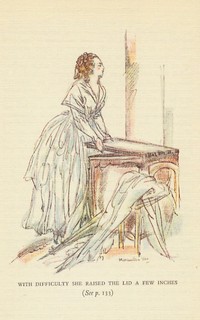 “And by my treatment of the pictures I have tried to attune myself to an art which never stresses, records only the essential, draws rather than paints: an art which aims at grace and rhythm rather than at intensity of expression.” Maximilien Vox on Jane Austen
“And by my treatment of the pictures I have tried to attune myself to an art which never stresses, records only the essential, draws rather than paints: an art which aims at grace and rhythm rather than at intensity of expression.” Maximilien Vox on Jane Austen
Many book illustrators have attempted to interpret Jane Austen’s characters over the years. Some have succeeded, though it is a challenge for any artist to transform the essence of Austen’s intension visually since so little description was forthcoming in her novels, leaving the reader to apply their own interpretation. Even though I admire this artistic choice by Austen, her illustrators have had a less than clear picture and have taken free rein. One artist that added his own unique view was Maximilien Vox (1894-1974), a distinguished French illustrator, painter and art critic best known as a typographer, historian and teacher. In the 1933-34 editions of The Works of Jane Austen, illustrated by Maximilien Vox, [1] published by J. M. Dent & Sons Ltd., London, Vox adds his distinctive style to the seven volume set which includes the six major novels, and one volume of Sandition and other miscellanea.
Each book contains eight sepia line drawings enhanced with delicate pastel watercolours representing significant scenes from the novels chosen by the artist. As you can see by the several images from each of the novels and miscellanea, they are much different in style than his famous Victorian predecessors the brothers C. E. & H. M. Brock, or Hugh Thomson. By 1933, the Art Deco movement that had originated in Paris was in full swing, inspiring Monsieur Vox who resided in the Mecca of progressive art. You can see the Deco influence in his approach, with simplistic forms, characters expressionlessly gazing away from the viewer, and a stylistic choice of the pale pallet of sepia for the lines and pastels for the forms.
This fresh and unique artist was the choice of Hugh Dent, the son of the famous London book publisher Joseph Malaby Dent (1849-1926) who founded J. M. Dent & Sons in 1888. J. M. Dent was a self made man and visionary who created the Everyman’s Library series bringing the classics to the masses at reasonable prices. In 1892, J. M. Dent published a ten volume set (sold separately) of The Novels of Jane Austen presenting new illustrations by William C. Cooke and edited by R. Brimley Johnson. This edition is considered ‘the first really independent issue of novels – Bentley’s edition having previously held the field.’ [2] J.M. Dent also began publishing high quality limited editions of classic literature under the Temple Library imprint in 1894 which included another ten set edition of The Novels of Jane Austen featuring colored illustrations by C. E. and H. M. Brock. [3] This is the edition that has been heavily reproduced over the years making the Brock brothers the most published illustrator connected to Jane Austen.
Included in the first volume, Sense and Sensibility, is an unusual addition following the introduction by Emile Legouis; a letter to the editor Hugh Dent by the illustrator himself and written in French (and translated into English) . This revealing missive gives us a look into the illustrator’s inspiration and creative process for his artwork. Of note is his admiration and esteem for Austen’s work, and the inclusion of a quote from Sense and Sensibility to conclude his letter relaying his complete understanding and reverence for his subject and her characters. His aim in emulating Jane Austen’s genuis as “an art which never stresses, records only the essential, draws rather than paints: an art which aims at grace and rhythm rather than at intensity of expression.”, is achieved with his own delicately nuanced interpretations.
 Prefatory Letter by Maximilien Vox
Prefatory Letter by Maximilien Vox
Dear Mr. Dent,
Now that I have finished the illustrations of Jane Austen’s novels I have, I assure you, much for which to thank you. Firstly for the pleasure of our personal relationship; secondly for the perfection of the coloured reproductions, in which the character of the line and freshness of tone of the originals have been so faithfully followed; and finally because it is a privilege for a French artist, who is partly British by descent and culture, to offer his work under your patronage to the judgment of the English public.
But above all I am grateful to you for the opportunity you have given me of steeping myself in a work so charged, not only with genius, but with hidden meaning and delicate nuances. I have attempted, in each book, by my drawings, to differentiate the individuality and original psychology underlying the superficial similarity of character and plot, and to show how this world, apparently composed entirely f well brought-up young ladies, eligible young gentlemen, and sententious middle-aged ones, really comprises a complete universe by virtue of its variety and dramatic resource, And by my treatment of the pictures I have tried to attune myself to an art which never stresses, records only the essential, draws rather than paints: an art which aims at grace and rhythm rather than at intensity of expression.
As for costume and fashion, I have only indicated them, emphasizing simply the changes from the eighteenth century to early nineteenth. And this, perhaps for a Frenchman, is the most striking evidence of the nationality of Jane Austen’s work – that she portrays as a period of slow, almost imperceptible social transition that very period which in our history stands for violent revolution. For in all respects, in her picture of manners and ideas, Jane Austen belongs to the century in which she is born, and which has given her so international an outlook that she might well belong to us; she would have caused us
no surprise by signing herself ‘Mademoiselle Jeanne Austain’.
Such at any rate, dear Mr. Dent, are the various ideas which have governed the play of my pencil on the paper; you will forgive me if, to use our author’s words, ‘I have brought no Restraint to the Expression of Sentiments in themselves not Illaudable’. [4]
M. V.
Pairs, 15 January 1933
Footnotes
- Gilson, David – A Bibliography of Jane Austen, St. Paul’s Bibliographies, Winchester (1997) E181, pp308
- Gilson, David – A Bibliography of Jane Austen, St. Paul’s Bibliographies, Winchester (1997) E76, pp263
- Gilson, David – A Bibliography of Jane Austen, St. Paul’s Bibliographies, Winchester (1997) E90, pp272
- Austen, Jane – Sense and Sensibility, chapter 11 “Elinor could not be surprised at their attachment. She only wished that it were less openly shewn; and once or twice did venture to suggest the propriety of some self-command to Marianne. But Marianne abhorred all concealment where no real disgrace could attend unreserve; and to aim at the restraint of sentiments which were not in themselves illaudable, appeared to her not merely an unnecessary effort, but a disgraceful subjection of reason to common-place and mistaken notions. Willoughby thought the same; and their behaviour at all times, was an illustration of their opinions.”






Excellent, excellent post, Laurel Ann. Everything you wrote in it informed me of something interesting and new. I have never heard of Maximilien Vox before, and I’m sure many others haven’t either. His delicate drawings are lovely. I’ve often wondered what goes through an illustrator’s mind when interpreting a novel, which Vox’s letter does superbly. – Vic
LikeLike
Now you’ve done it, Laurel Ann. I now am searching for a book of Vox’s illustrations. I loved this post and will bookmark it and share it. Very intersting, and his illustrations are quite the tribute.
LikeLike
Laurel Ann, do you know the illustrations from William Sewell?
Thanks,
Adriana Zardini
LikeLike
Adriana – no I am not familiar with William Sewell. Did he illustrated edition of Jane Austen?
LikeLike
Laurel Ann,
I hope so! I bought a book in a virtual bookstore and I’m waiting to receive it. When the book arrives I can show it to you.
By the way, to you know the illustrations of D. C. Eyles? I bought a rare book, probably from the 30s with his illustrations: Northanger Abbey and Persuasion
LikeLike
William Sewell lived in our house around 1911 and certainly illustrated a few books here.
I’d love to hear about any edition of Jane Austen he may have illustrated.
LikeLike
I did some digging on William Sewell as an illustrator of Jane Austen editions and found an editon of Emma published by LONDON COLLINS CLEAN-TYPE PRESS Circa 1910 listed at ABE.com. I could not find a listing for this book in my copy of A Bibliography of Jane Austen, by David Gilson (1997). Hope that helps.
LikeLike
It exists and is sitting right next to me. Maroon, letherette (?) cover, gilt-edged pages, cracked binding…
Does anyone know where I can get the collection appraised?
Thanks,
Shira
LikeLike
The post is really late here in Brazil… I guess because of the holidays. So… as soon as I can I will post it ok?
Adriana
LikeLike
Many thanks, Laurel Ann, that’s really interesting. I guess he might have gone on to illustrate some more Jane Austen editions had he not died in World War I in 1916.
LikeLike